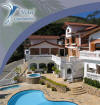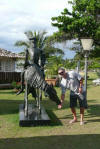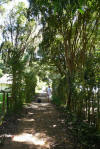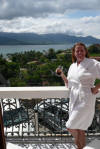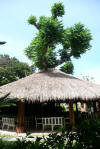Diary/Photo Journal
Week of January 06, 2008
We start this week still treasuring our time on top-of-the-world and watched a storm blow itself out just in time to enjoy our lunch outside on the "veranda". Just a relaxing start to the week as Gerson and I were to go alone on to the State of Rio de Janeiro.
On our way, we were bombarded with magnificent views around every curve of the coastline and we probably would have reached our destination in half the time if not for the many stops we made to take in the sights.
We toddled into Sao Sebastiao and got the ferry across to the Ilha Sao Sebastiao (also called Ilhabela for its main village). The island has a road that runs the length of the island on the West side and the East side of the island is only accessible by 4-wheel drive (sometimes) over the middle and by boat. If there are heavy rains, as there were just prior to our visit, the road over the island is not passable in any vehicle. Ihlabela sits just off the mainland and is a playground for the "Paulistas" and international tourists.
We stayed in a wonderful hotel that overlooked the channel between Ilhabela and the mainland. As it was easier to park the car and just walk into town, it was worth the 5 kilometer (3.5 mile) walk along the shore.
For a day trip, Gerson chose the northernmost beach, Jabaquara (at the end of the road) and as we arrived before noon (which is when the Brazilians are just waking up!), we had the beach to ourselves. Soon enough, the sands were dotted with colorful umbrellas and bright towels. We enjoyed a long snorkel around one end of the small bay and after several hours in the intense heat, we had our lunch on the beach and then headed home.
Ihlabela is a beautiful place; however, I
would not recommend a visit because of its rather unwelcoming (or perhaps,
over-welcoming) inhabitants called "borrachudos" (boh-ha-shoo-does) or as I very
non-affectionately call them now, "butt-biters". These little
buggars were supposed to be repelled by the local concoction that includes
citronella. Either I missed a whole lot of spots when I applied this
so-called "guaranteed" repellent, or the "butt-biters" have a good laugh at the
expense of those of us using the repellent.
Based on where I was lunched upon, I am voting for the latter. These voracious pests have a very cheeky sense of humor. They got me several times under my arms so when I have to scratch the huge welts, I look like I am imitating a monkey. They also bit me many times at the base of my bum so when I cannot resist the itch anymore, I walk down the street looking like I am scratching my arse. The final insult were the bites just under my breasts, where the bikini top meets my ribcage. So, when I just have to relieve the skin of its itch, I look like I am fondling myself.
So basically, I have been walking down the street with 40+ bites, looking like a monkey, scratching my arse and fondling my breasts. Yep, I was the epitome of an attractive sight for a couple of days.
After a rather uncomfortable sleep (I actually contemplated sleeping in the shower to let the cold water run over my body as I had burning bites from my shoulders to the tips of my toes), I crawled into the car and we journeyed further up the coast. Fortunately, the day was so fantastic that I could forget about my misery for a time and truly enjoy mother nature's glory.
We stopped off for a brief jaunt at a beach called Puruba, wherein we took a short boat ride across a "sweetwater" river to access the beach. We walked up and down the open sands and then continued our drive. Not missing the opportunity for a pleasant lunch on the beach, we stopped off at a little bar and restaurant overlooking a small bay.
Aiming for Paraty (pair-a-chee), we made it to our Hotel Coxixo, right in the heart of the village's historic downtown. In the late 1700's, Paraty grew in size due to its being a stopover for the gold being moved from Minas Gerais to Rio. The colonial waterfront remains relatively the same as it was over 200 years ago and as there was no road to the city until 1954, the original city seems to be relatively untouched by modern architectural influence.
It is difficult to truly represent the charm and beauty of this city. Each building has a variety of colors on its doors and windows and these colors were at one time, very important. As they did not use a numbering system for addresses, the homes and buildings were identified by their colors: "I live in the house on the third street with the blue doors and red windows"...
The town is lined with stone streets that are called "pesde-moleque" (street urchin's feet). As you walk the streets, you notice that there are a line of stones straight down the center and this is representative of where the sewers used to be located. Over 200 years ago, long before plumbing, the people would empty out their waste into the center of the street and it would be carried downward toward the bay. Assisting this disposal process, were the high tides that would come several times a month and would engulf the village's streets and wash the sewers clean.
Not a system to be recommended today; however, at the time, it led to a rather clean city (and a not so clean shorefront). When we returned from a day visiting several islands, we witnessed the high tide phenomenon for ourselves as the streets closest to the bay were flooded and the waters were slowly receding back into the ocean.
So many details of the town can be missed if you are too busy watching your step (as horses and dogs share the street with us humans). In the Portuguese style, many of the building's soffits still had the tiles that decorated these edges and the gutters and downspouts were truly works of art.
Gerson made sure and booked us seats for a famous puppet show performed by Teatro de Bonecos (if you go to this link, you can watch a short video of the show). The puppet show is unlike anything I had ever seen as these were extremely lifelike "dolls" that were hand manipulated directly on stage. The performers would be dressed entirely in black and blend into the dark background so that all you saw was the movement of the puppet. Although a remarkable show, there were a few rather odd moments within the seven different "plays" that were shown. This particular puppet presentation has played around the world and is considered "world renowned". It definitely is an art that is not seen enough and probably will be lost within the next generation.
As the weather was fantastic, we chose to join in with a chartered schooner and travel to several small islands around Paraty. We knew we were in for a great day when just looking back on Paraty was a beautiful sight.
   |
Views of the harbor and the town's shoreline |
  |
Taking advantage of great photo opportunities
Small islands, both private and government owned,
dot |
We took advantage of the 50' visibility and the warm waters and snorkeled at two of the islands. Fish were in abundance and the starfish punctuated the mottled greens and browns with orange and yellows. Gerson said he saw three sea turtles that of course, were no where to be found when I came in the same area with my camera. Speaking of my camera, we found this awesome thick plastic bag setup that fits a digital camera and provides a small base (that attaches to where you would place your tripod) and was proven to be waterproof. I was happy to get some great pictures of our underwater experience.
We had a nice lunch on the boat and enjoyed the acquaintances of three Australians that just happened to be sitting next to us. Alex, Jess and Jill were three young women traveling for a few weeks between Brasil and Argentina and were on the last bit of their trip. Like us, they loved Paraty and its quaintness. Of course, sailing on turquoise waters with nice people was not too bad either.
After our wonderfully exhausting day, we decided to do another snorkel-beach day and got an early start the following morning. We ventured back south a bit to a unique beach area called Trindade. This area is known for its sea-water lagoons that are formed because of the large rock formations that surround the pools. The water in the pools is about waist deep and to get to them, you can either walk a few kilometers along the beaches or take a quick boat shuttle directly across the bay.
We opted for the boat shuttle as we were carrying our snorkeling equipment and basically because we were lazy (and still tired from all the swimming the day before - we are getting so old). Arrival into the lagoon means slipping past two rock sentinels and being walked to the ankle-deep water to disembark. The water was like bathwater and apparently many people preferred the warm water as there was very little room to move without tripping over someone.
We decided to climb over the rocks and take our snorkeling leap from the bay side of the lagoon. Sounds easy until you realize the rocks are scorching hot and there are those little things called 'barnacles' that just love to tear up your feet. As a result, we slipped on our fins and clumsily waddled over to the edge of the rocks. Gerson, of course, slipped into the water with no problem, yet I was not so lucky. Having misjudged my balance and the waves, I stepped (fortunately lightly) onto a sea urchin and a spine found its way through my fin and into the heel of my foot. I extracted the spine from the fin and my heel showed no sign of puncture so off we went.
The water was again clear and beautiful and we swam between refreshingly cold currents and bathwater warm flows (as the water remains cool in the shade of the boulders and warms in the shallows). While snorkeling, we saw a variety of fish and my highlight was literally running into a type of squid that was so many different colors that it reminded me of a peacock's feathers.
    |
Beautiful reef colors and lots of fish A very cool looking squid just |
    |
Our jumping off point with the
boat shuttle across the bay The sentinel boulders Our shuttle back to the beach |
We left the way we came in, through a small town and via a dirt road tightly wrapped by the jungle. We even had to cross a small river that empties itself into the ocean just after pouring across a sheet of rock. The crossing was easy as was the rest of the day.
The next day, we left for Rio de Janeiro and again were awed with fantastic views. Unfortunately, some of those views included the "favelas" that seem to surround Rio and remind you of the true poverty and crime that infests the beautiful city. We spent the evening getting settled into our hotel and catching up with Gerson's old friend Alex and his wife, Nyria and their daughter, Barbara.
We ended our week with our making plans for a couple days with Gerson's cousins on their "fazenda" or farm just outside or Rio.
Home Page
Brasil III Diary Index
Previous Diary page Brasil III Diary page
8











